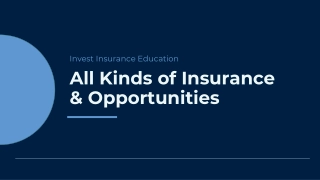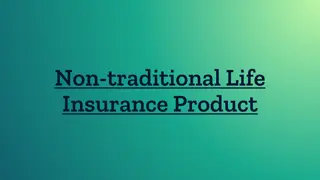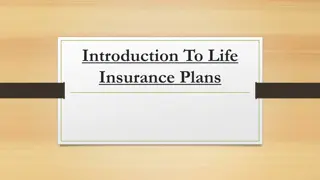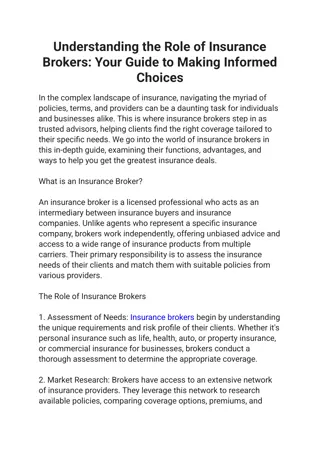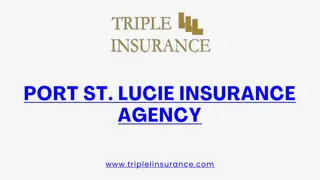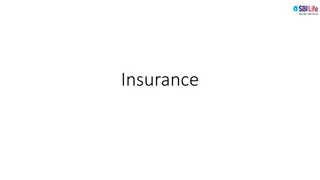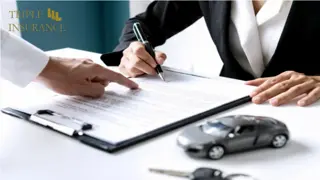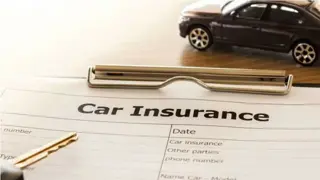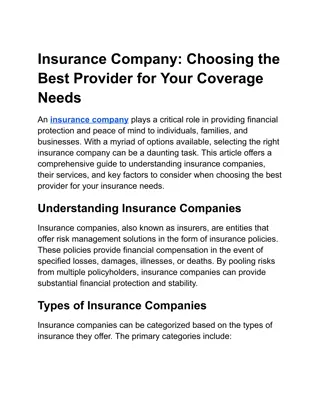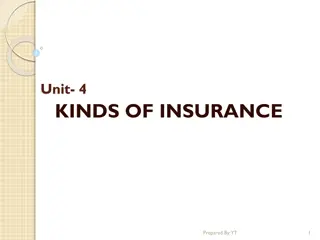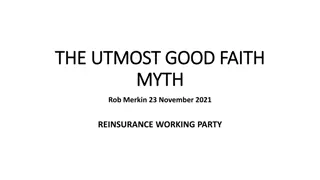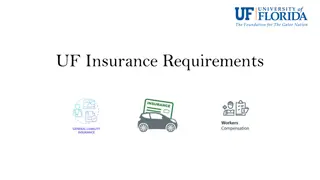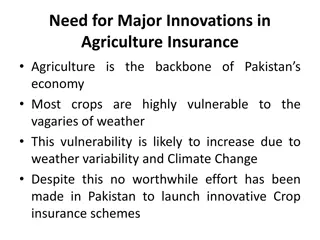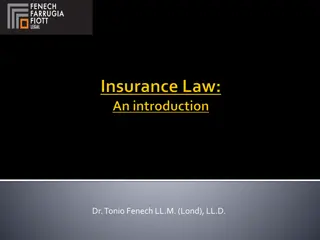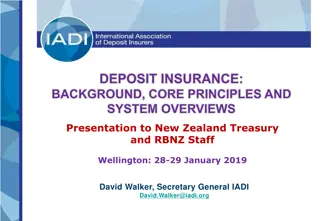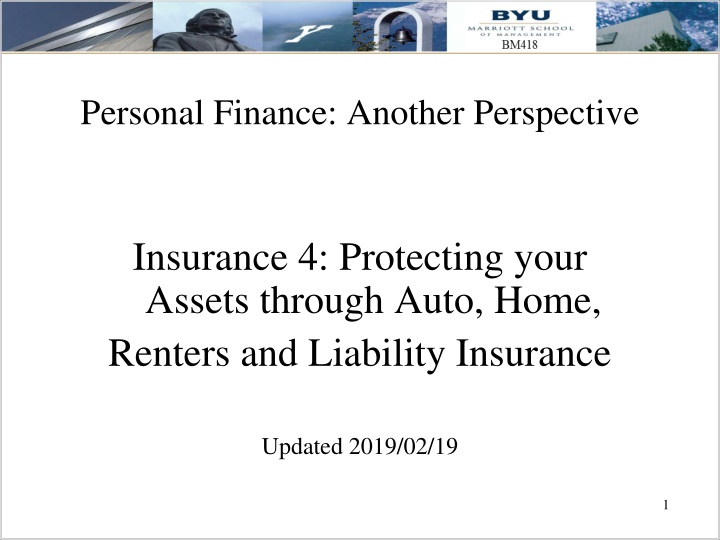
Protecting Assets: Auto, Home, Renters, and Liability Insurance Overview
Explore how auto, home, renters, and liability insurance can safeguard your assets, reduce costs, and obtain vital CLUE reports. Understand key coverage areas and get tips for protecting your financial well-being at different life stages.
Download Presentation

Please find below an Image/Link to download the presentation.
The content on the website is provided AS IS for your information and personal use only. It may not be sold, licensed, or shared on other websites without obtaining consent from the author. If you encounter any issues during the download, it is possible that the publisher has removed the file from their server.
You are allowed to download the files provided on this website for personal or commercial use, subject to the condition that they are used lawfully. All files are the property of their respective owners.
The content on the website is provided AS IS for your information and personal use only. It may not be sold, licensed, or shared on other websites without obtaining consent from the author.
E N D
Presentation Transcript
Personal Finance: Another Perspective Insurance 4: Protecting your Assets through Auto, Home, Renters and Liability Insurance Updated 2019/02/19 11
Objectives A. Understand the key areas of Auto Insurance and how to keep your costs down B. Understand the key areas of Homeowner s Insurance and how to reduce your costs C. Understand the key areas of Renter s Insurance and how to reduce your costs D. Understand the key areas of Liability Insurance E. Understand some Plans and Strategies to protect your assets for different stages of your life 2
Your Personal Financial Plan Would like to know what is on your auto and home insurance reports? Under the FACT Act (Fair and Accurate Credit Transactions Act of 2003) you can obtain the following Comprehensive Liability Underwriting Exchange (CLUE) reports each year: CLUE Auto: A 5-year loss history report of your automobile claims (if a loss was filed against your automobile insurance policy and if the insurance company reported the information to CLUE) CLUE Personal Property: A 5-year loss history report of your homeowners claims 33
Your Personal Financial Plan (continued) How do you get your CLUE report? Go to http://personalreports.lexisnexis.com, click on Insurance Report, then Both Reports, then fill out the form and mail it in. This is part of the FACT Act They will receive your order, verify the information, and they will mail it to you Most of you will have a clear report, i.e., no information If you have claims, copy the report and include it with your PFP You can also dispute the information if it is not correct and if you are planning on switching insurance companies 44
A. Understand the Key Areas of Auto Insurance What is auto insurance? Insurance against financial loss due to an auto accident. It is a contract where you agree to pay the premium and the insurance company agrees to pay up to a specified amount for any policy defined losses. Losses in excess of policy limits are your responsibility Most states require a minimum insurance coverage before you can legally drive The four coverage areas are liability, medical payments, uninsured/underinsured motorist s protection, and damage to your car 55
Part A: Liability Coverage What is liability coverage? Liability coverage may be a single limit or a split- limit coverage. It is payment for losses due to: Bodily injury: Death or injury for all those involved in the accident Property damage: All damage to the car or cars and any property damage Losses due to lawsuits: Losses from lawsuits resulting from the accident Defense costs in addition to your policy limits in civil trials: Defense costs in case the accident goes to trial 66
Auto Split-Coverage Limits What are auto split-coverage insurance limits? 100/300/50 (my recommended minimum coverage) These limits have reference to your coverage amounts. It means: $100,000 of bodily injury liability per person $300,000 of bodily injury liability per accident $50,000 of property damage per accident These are the maximum amounts your insurance company will pay per person or per accident. Should the cost of the accident exceed the stated limits, you are personally responsible for any amounts exceeding these limits 77
Part B: Medical Payment Coverage What does medical payment cover? It covers all reasonable medical costs and funeral expenses incurred, by the insured or the insured s family members within 3 years of an accident. It also includes coverage for the insured when walking. What doesn t it cover? It does not cover medical expenses if the insured is injured by a vehicle not designed for public streets, such as an unlicensed 3 or 4 wheeler (quad, four wheeler or go cart) My recommended minimum coverage is $50,000. 88
Part C: Uninsured/Underinsured Motorist s Coverage What does uninsured/underinsured insurance cover? It covers: Costs if injured by an uninsured motorist or a hit-and-run driver. The other driver must be at fault to collect on this coverage. Costs in excess of the other driver s liability coverage (i.e., under-insurance), if it is inadequate to pay for your losses. My recommended minimum coverage is the same as your other liability coverage 99
Part D: Comprehensive Physical Damage Coverage What does comprehensive physical damage cover? It covers collision loss regardless of who is at fault If the other driver was at fault and has liability insurance, your insurance company should be able to recover losses without collision coverage from the other driver s insurance company Other than collision, it covers comprehensive physical damages My recommended minimum coverage is $100,000. Remember that deductibles apply. 10 10
Standard Exclusions What are exclusions? Contract clauses which limit the insurance company s liability in specific situations or events Your insurance may not pay up if: There is intentional injury or damage There was use of the vehicle without permission The vehicle has less than four wheels Someone else s vehicle was provided on a regular basis It s your automobile, but not listed on your policy You were carrying passengers for a fee You were driving in a race or speed contest 11 11
No-Fault Insurance What is no-fault insurance? No fault insurance is insurance coverage that pays for each driver s own injuries, regardless of who caused the accident No-fault varies from state to state. Such policies are designed to promote faster reimbursement and to reduce litigation Where is no-fault insurance available? It is only available in no-fault states Utah is no-fault state 12 12
No-fault Insurance (continued) What are the advantages of no-fault insurance? It is easier and faster. Your insurance pays for your losses and their insurance pays for their losses What are its disadvantages? Generally damages from pain, suffering, emotional distress are not covered There are dollar limits on medical expenses and lost income. Losses above limits are not covered. Vehicle damage is not covered. Your or other s collision coverage would need to be used to repair the vehicles There are liability thresholds where your pursuit of a liability lawsuit may be restricted by the set limits 13 13
Buying Automobile Insurance What are the determinants of the cost of auto insurance? The cost of Automobile Insurance is determined by: Type of automobile Use of automobile Your personal characteristics Your driving record Where you live Discounts for which you qualify 14
Keeping Your Costs for Automobile Insurance Down What are your 10 recommendations to keep the cost of automobile insurance down? 1. Shop comparatively Know what other insurance companies are charging for similar coverage from the same area and vehicle. 2. Consider only high-quality insurers Insure with companies with the highest ratings from A.M. Best (A and higher), Fitch (AA and higher), Moody s (Aa2 and higher), or Standard and Poor s (AA and higher) 15 15
Keeping Auto Insurance Costs Down (continued) 3. Use any and all discounts that you can Discounts reduce your costs Apply for all discounts you can for you and your children, i.e. non-smoking, non-drinking, good student/grades, multiple policy, multiple vehicles, new parents, antilock brakes, passive restraints, group discounts, etc. Always ask: Are you sure you can t do better than that? Are there any discounts we have not yet talked about? 16 16
Keeping Auto Insurance Costs Down (continued) 4. Buy vehicles that are inexpensive to insure Look to your insurer for the types and costs of specific vehicles check vehicle costs before buying Buying extra safety and anti-theft devices may reduce your costs check with your insurer 5. Drive defensively Improve your driving record Don t get tickets, but if you do: Go to traffic school whenever possible to keep tickets off your record 17 17
Keeping Auto Insurance Costs Down (continued) 6. Raise your deductibles If you must cut costs, cut here and raise your deductibles (but not your liability coverage) Hold children accountable for deductibles and accidents Drop comprehensive and collision completely once the value of your car drops below $2-3,000. 7. Keep adequate liability insurance Never reduce your liability limits to reduce costs!!!! Liability insurance is cheap keep your limits high 18 18
Keeping Auto Insurance Costs Down (continued) 8. Be very careful of who you let use your car If a friend causes an accident in your car, you (and your insurance company) will likely foot the bill 9. Improve your credit score and keep it high Maintain a high credit score. It will reduce your insurance costs 10. Review your insurance coverage on a regular basis Review costs, liability limits, and discounts Make sure all vehicles are included on the policy Review your CLUE auto report once each year at www.choicetrust.com and make sure it is correct 19 19
Filing a Claim Using Your Automobile Policy 1. Use wisdom in your actions Help the injured, call the Police, cooperate, and get the Police case number when it is completed Move vehicles or put up flares for safety. Make sure you have flares in your vehicle emergency kit Get the names of any witnesses Insist all drivers take an alcohol test if that s a concern 2. Keep calm and in control Record your recollections, but don t admit guilt Be firm on your views speak up and give pertinent information even if it contradicts the other drivers comments 20 20
Filing a Claim (continued) 3. Follow up properly after the accident Get the other driver s insurance company name Call your insurance company as soon as possible Cooperate with your insurer and claims adjuster Obtain a copy of the police reports Keep records of all accident expenses Review the settlement steps in your policy If you are dissatisfied with the settlement offer, request a meeting with your agent and adjuster. If still not satisfied, contact your insurance company s consumer affairs office or state insurance commissioner. 21 21
B. Understand the Key Areas of Homeowners and Renters Insurance What is the purpose of Homeowners Insurance? Homeowners insurance repairs or replaces your home from specific perils or accidents including: Fire, theft, storms Faulty household systems or appliances Riot, volcanoes, vehicles, aircraft Why is homeowners insurance so important? Your home is likely the largest single purchase you will ever make. As such, that purchase needs to be protected 22 22
Homeowners Insurance (continued) What are the three areas of Homeowners insurance? Dwelling: direct and consequential loss resulting from damage to the dwelling itself Personal Property: loss or damage to personal property Liability: liability for unintentional actions arising out of the non-business, non-automobile activities of the insured and the insured s family 23 23
Homeowners Insurance (continued) What is the purpose of Renters Insurance? Renters insurance repairs or replaces your rental property s contents from specific perils or accidents including fire, theft, storms, water damage, etc. It also provides liability insurance against accidents caused by you or a member of your family Why is it so important? Your landlord has insurance only for the rented property and building. You are responsible for your contents and the liability risks you and your family bring. Renters insurance is cheap and protects your property regardless of location 24 24
Six Basic Homeowner's Policies How is homeowners/renters insurance sold? It is sold in six basic versions HO-2: A broad form homeowner s insurance Covers only named specific named perils. These perils may be fire, lightning, hail, explosions, etc. If the peril is not named, it is not covered by the policy In general, all forms of coverage exclude law, earth movement, water damage, power failure, neglect, war, nuclear accidents, and intentional loss 25 25
Six Basic Homeowner's Policies (continued) HO-3: A special form of homeowner s insurance that includes open perils for dwelling. This is generally recommended at a minimum. Covers all direct physical losses to your home, i.e. open perils protection. It lists specific exclusions to the policy for perils not covered Personal property is still named peril 26 26
Six Basic Homeowner's Policies (continued) HO-4: Renter s or tenant s insurance Equivalent to HO-2 perils for personal property, but only for renters and tenants Covers personal property rather than the dwelling Provides liability coverage in case an accident, but does not cover causing damage to the structure All-risk coverage available as an option (this is recommended) 27 27
Six Basic Homeowner's Policies (continued) HO-5: A new special form homeowner s insurance It includes open perils and includes a rider (HO-15) that allows open perils coverage on personal property in addition to other coverage Covers all direct physical losses to your home, i.e. open perils protection Listed exceptions are the same as HO-3 28 28
Six Basic Homeowner's Policies (continued) HO-6: Condominium owner s insurance Similar to HO-4 coverage, has the same named perils for personal property as HO-2, but is available to co- op or condominium owners Also covers improvements you ve made All-risk coverage is available as an option (recommended) 29 29
Six Basic Homeowner's Policies (continued) HO-8: Modified coverage for older homes Insures the dwelling for the repair cost or market value, instead of the replacement value Is designed specifically for older homes All-risk coverage available as an option (recommended) 30 30
Homeowners Policy Coverage Sections What are the key areas of Homeowners Policy coverage: Section 1: Property Coverage A: Dwelling Protects the dwelling and any attachments Does not cover any damage to the land Coverage B: Other Structures Protects other, unattached, dwellings on property Covers landscaping as well as buildings, but not the land Does not cover other structures used for business purposes Is limited to 10% of the home s coverage 31
Section I: Property Coverage (continued) Coverage C: Personal Property Covers all personal property owned or used by the policyholder up to policy limits Covers personal property regardless of location Also covers property of guests in your home Personal Property Limits Limited to 50% of the home s coverage There is a $200 limit on cash, gold, and silver; $1,000 limit on securities, tickets, and stamps; and $2,500 limit on silverware Animals, birds, and fish are excluded 32 32
Section I: Property Coverage (continued) Coverage D: Loss of Use Covers losses incurred as a result of your home being uninhabitable or un-useable Limited to 20% of the amount of coverage on the home There are three benefits of coverage Additional living expenses should to need to relocate temporarily Fair rental value Prohibited use 33 33
Section II: Liability Liability applies to all of the policy forms Coverage E: Personal Liability The insurer will pay, to the limit of liability in the contract, all amounts due to bodily injury or property damage Coverage F: Medical Payments The insurer will pay all reasonable medical payments to others, claims, expenses, and damage to the property of others to the limits of the policy Other coverage includes claims expenses, first aid expenses, damage to the property of others, and loss assessment coverage 34 34
Supplementing your Policy Should you need to add additional coverage, a homeowners policy can be supplemented in a number of ways through specific endorsements: Inflation: This allows protection to increase with the increase in repair and rebuilding costs Floater Policies: These are policies that provide protection for valuable personal property over and above existing policy limits Flood, Earthquake and Terrorism Insurance: This provides protection in the event of a flood, earthquake, or terrorist activity 35 35
Know How to Keep Your Homeowner's Insurance Costs Down 1. Know your needs! Buy Guaranteed Full Replacement Cost coverage of your home in case of a complete loss (recommended). That way your home is replaced, regardless of what you paid for it Determine if other structures or landscaping on the property have adequate coverage. Consider extra coverage for special situations like floods or earthquakes, if applicable. Only consider extra coverage or a floater policy for very high-value items such as paintings, jewelry, or very valuable collections. 36 36
Keeping Homeowners Costs Down (continued) 2. Don t under-insure Insure for the replacement cost of the dwelling Remember coinsurance and the 80% Rule Dwelling must be insured to within 80% of the replacement cost. Coinsurance requires you to pay for a portion of the loss if you don t carry adequate insurance If not insured at least 80%, in the event of the loss, you will receive the greater of: Actual cash value of the portion of the home lost Insurance Coverage 80% of Replacement Cost x Value of Loss 37 37
Keeping Homeowners Costs Down (continued) 3. Select a financially sound insurer with low comparative costs and stick with them Shop around knowledge is power Utilize all discounts you can qualify for, including multiple policy discounts Check with www.ambest.com for your insurer s record and financial position Don t switch carriers to save a few bucks. A claim within 6 months may get you dropped Don t make small claims. Too many can cause your policy to be dropped 38 38
Keeping Homeowners Costs Down (continued) 4. Get a CLUE (Comprehensive Loss Underwriting Exchange) report for both your home and your automobiles Errors on your CLUE report and credit reports can boost premiums and cost you money Be careful that inquiries are not listed as actual Get your one free CLUE report each year in compliance with the FACT Act. Review both for your home and auto policies 39 39
Keeping Homeowners Costs Down (continued) 5. Reduce your insurer s risk by utilizing all possible savings methods Increase your deductibles, drop the add-on coverage for small claims, and add security systems/smoke detectors if cost effective 6. Know your coverage Read and understand your policy: The amount paid by the insurance policy will not exceed the limit of your policy You must rebuild on the same location. If you don t rebuild the insurance company will only pay for the actual cash-value loss rather than the replacement value 40 40
Keeping Homeowners Costs Down (continued) 7. Make your coverage work Keep an inventory establishing proof of ownership (preferably videotape and off site) of everything you insure and update it yearly Videotape the exterior of the home to value landscaping or condition 8. Keep your credit score high Insurance products have a pricing component based on your credit score Keep your credit score high Review your credit reports annually Get a copy of your credit score every two years 41 41
If You Have a Claim If you have a claim: Notify police immediately. Get copies of all reports Call your insurance company. Follow up with a written claim Develop a list of damaged/stolen/destroyed items Submit receipts for any additional living expenses Provide information as requested by claims adjuster Review the settlement steps in your policy If you are dissatisfied with the settlement offer, request a meeting with your agent and adjuster. If still not satisfied, contact your insurance company s consumer affairs office or state insurance commissioner 42 42
Questions Homeowners Insurance Summary 2019 Fin200/Fin418/MBA620 (02/18/19) Section 1: Property Any questions regarding homeowners and renters insurance? HO 02: Basic Insurance Coverage "Basic form" that provides insurance on a "named-peril basis for dwelling and personal property, " i.e., only covers losses listed on the policy Section 2: Liability Policy Type Description Coverage A: Dwelling Coverage B: Other Structures Coverage C: Personal Property Coverage D: Loss of Use Coverage E: Comprehensive Liability Coverage F: Medical Payments and Other Broad form, $15,000 minimum Broad form, 10% of A Broad form, 50% of A Broad form, 20% of A All amounts due to bodily injury or property damage to policy limits All amounts for medical and property payments to others to policy limits HO 03: Broader form, includes open perils (this has been the standard form for decades) "Broad form" that provides "open- peril" insurance on dwelling and structures but "broad form" on personal property Open Peril, $20,000 min Open Peril, 10% of A Broad form, 50% of A Open Peril, 20% of A All amounts due to bodily injury or property damage to policy limits All amounts for medical and property payments to others to policy limits HO 04: Renters, or Tenant's Insurance Renters insurance with liability and personal property covered up to the policy limits Not covered Not covered Broad form, $6,000 min Broad form, 20% of C All amounts due to bodily injury or property damage to policy limits All amounts for medical and property payments to others to policy limits HO 05: Broader form, incl. open perils coverage on Personal Property (only for newer homes, higher values and well maintained) "Comprehensive form" that covers both the home and personal property on an "open-perils" basis--broadest form of insurance available Open Peril, $20,000 min Open Peril, 10% of A Open Peril, 70% of A Open Peril, 30% of A All amounts due to bodily injury or property damage to policy limits All amounts for medical and property payments to others to policy limits HO 06: Condominium Insurance Condo policy that generally cover personal property and condo structure from the wall studs in $1,000 Included in A Broad form, $6,000 minimum Broad form, 40% of C All amounts due to bodily injury or property damage to policy limits All amounts for medical and property payments to others to policy limits HO 08: Modified coverage for Older Homes Policy used to insure older homes that would be difficult to replace if destroyed, hence the home is insured at market value Basic, $15,000 Basic, 10% of A Basic, 50% of A Basic, 10% of A All amounts due to bodily injury or property damage to policy limits All amounts for medical and property payments to others to policy limits 43 43 HO-3 Standard Named Perils: These include theft, fire, explosion, smoke, freezing, vehicles, falling objects, volcanic eruption, windstorm or hail, riot or civil commotion, aircraft damage, vandalism, snow damage, water damage. Excluded generally from HO-3 and HO-5: These include power failure, pollution, earth movement, flood damage, intentional loss, war, nuclear accident, pets, settling, wear and tear, negligence, actions by government, legal action, theft or damage from vandalism, and deterioration due to weather
C. Understand the Key Areas of Personal Liability Coverage What is a liability? A liability is the financial responsibility one person has to another in a specific situation. Liability results from the failure of one person to exercise the necessary care to protect others from harm What are the cost of a liability? Every year thousands of people are sued for $1 million or more over the use of their cars or homes which they or their children are liable for What is the purpose of Personal Liability Coverage? Personal liability coverage protects the policyholder from the financial costs of legal liability or negligence 44 44
Personal Liability Coverage (continued) What are the two major forms of liability insurance? The liability portions of homeowners and auto insurance and an umbrella liability coverage What is an umbrella liability coverage or policy? An insurance policy that adds protection over and above the insured s homeowners and auto policies, i.e., the policy becomes effective only after the limits of the homeowner s and automotive policies have been reached As such, many companies require specific coverage limits, i.e., 250/500/100 insurance on all vehicles and $300,000 on the home before they will write an umbrella coverage 45 45
Personal Liability Coverage (continued) Can you add more and specific coverage to your liability insurance? You can add supplemental coverage or endorsements to your homeowners policy on: Personal article floaters Earthquake coverage Flood protection Inflation guard Personal property replacement cost coverage 46 46
D. Understand Asset Plans and Strategies Following are a few ideas for asset protection plans and strategies over different time periods Asset Protection - Students and young marrieds Keep your credit score high Have adequate auto insurance, with a minimum 100/300/100 split coverage initially Have adequate renters or homeowners insurance. If you get renters insurance from your auto insurer, there is likely a reduction in auto costs Keep an adequate emergency fund. Raise your auto and home deductibles to reduce costs and co-insure a greater proportion of assets 47 47
Asset Protection Plans and Strategies (continued) Asset Protection - Married with families Raise your split coverage to 250/500/100 to offer more protection when you have teenage drivers Make sure teenage drivers keep grades up, take safe- drivers courses and use all good student discounts Stay ticket free. If you get a ticket, go to traffic school and get the ticket removed from records Make sure house has at least HO-3 coverage and add riders for additional coverage needed. Raise your auto and home deductibles to reduce costs and co-insure a greater proportion of assets Consider an umbrella policy to reduce the risk of future litigation expense as your assets rise Buy Guaranteed Full Replacement Cost coverage 48 48
Asset Protection Plans and Strategies (continued) Asset Protection - Empty nesters Make sure you have sufficient auto and home insurance to meet your family s needs Review your insurance needs annually to ensure you have adequate coverage and Guaranteed full replacement cost coverage As children leave, make adjustments to your insurance to be cost effective with coverage Take into account toys that are used for kids and grandkids in considering insurance and keep coverage up Consider an umbrella policy to reduce the risk of future litigation expense as assets increase 49 49
Review of Objectives A. Do you understand the key areas of Auto Insurance and how to keep your auto insurance costs down? B. Do you understand the key areas of Homeowners Insurance and how you can reduce your homeowners costs? C. Are you familiar with the key areas of Liability Insurance? D. Do you understand strategies to protect your assets? 50

